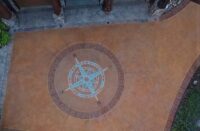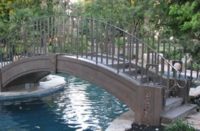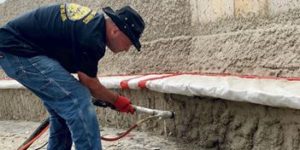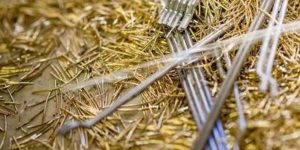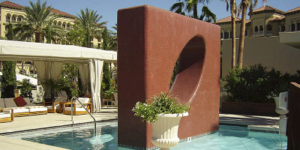While swimming pools and road construction projects have been the mainstay of many contractors in the shotcrete industry, a number of shotcrete artists are taking the concrete medium to new levels of creativity and usefulness.
Shotcrete is very versatile. It has many decorative uses: artificial rock work, faux trees and much more. “Shotcrete gives you the opportunity for options,” says David Long, president of Lakeland Co. in Rathdrum, Idaho. “It’s endless what you can do with it.”

Long and his peers have carved a distinct niche: decorative applications of shotcrete. Museums, zoos, aquariums, theme parks and resorts often make extensive use of decorative shotcrete to create wildlife habitats or realistic-looking environments where using the real thing would be a challenge or impossible, such as in the case of massive boulders.
Stephen Dodson, director of rock work at The Nassal Co. of Orlando, Fla., reports there is a decline in the desire for themed environments, such as themed restaurants and retailers, because there is a feeling those facilities were overbuilt, but there is a demand for new amenities and large-scale environments. For example, he says, his company recently finished the addition of a river amenity on Grand Cayman Island. “We used over 2,700 cubic yards of shotcrete to make a river — really a huge pool — where there are fish you can swim with. And an adjacent pool with sharks is separated only by a clear acrylic wall, so it is like you are swimming with sharks.”
 |
 |
Long is working on a project at a Cabela’s outdoor-goods store to create a sweeping mountain-themed environment. For another client, he is creating a 184-foot-by-90-foot rhinoceros. “You’ll be able to see it from the space shuttle,” he says.Recently Lakeland Co. completed an expansion at Oklahoma City Zoo using a couple thousand yards of shotcrete to encase a 25-foot-tall tilt-up building in artificial rock.
Faux mountains, faux forests and faux just about anything are possible with shotcrete, according to the shotcrete artists who spoke with Concrete Decor. As David Johnson Jr., president of Applied Concrete Technology Inc. of Grayslake, Ill., observes, “Shotcrete has always been a way to bring in natural-looking items you couldn’t otherwise bring in. For example, with shotcrete you can bring in a mountainside without bringing in a single real rock.”
And decorative shotcrete projects don’t have to be huge projects. There are plenty of smaller decorative applications out there.
Michael Dahl, president and owner of Michael Dahl Concrete Designs Inc. of Toledo, Ore., focuses on skate parks, rocks, residential landscapes and decorative retaining walls. “It’s a great technique to have in your bag of tricks,” he says. “I love working with shotcrete. It’s like a big concrete airbrush.”
And it’s a medium where your artistic touch is a large part of the job, he adds.

Dodson, Long and others have also taken the decorative aspect into a fairly new arena: architectural facades. Think faux brick, stone, wainscoting and more.
Dodson explains, “We’ve been using shotcrete to sculpt architectural finishes because of its strength and free-form ability.” For these kinds of finishes Dodson uses very small aggregate or none at all. “Typically we use sand or up to 3/8 minus aggregate.”
Shotcrete is quite useful in a variety of utilitarian applications, too.
Underground and mining specialist Mike Ballou of Sika Corp. in Taylorsville, Utah, reports the use of shotcrete in tunneling applications is on the rise. In underground mining, the process is to drill into rock, blast, muck and protect. Rock bolts traditionally are used to support the loads, and they are helped by shotcrete reinforced with welded wire mesh or steel or plastic fibers. “The main thing they’re trying to prevent is exposure to air so that it does not unravel, so they seal the exposed or mined areas,” he says.
Civil tunnels — for roads, trains, utilities, water and other purposes — are common and ideal candidates for shotcrete. “Most large cities have a tunneling project going on and, as they are being forced to build tunnels in soft ground, shotcrete is performing an important part of the job,” Ballou says. “Steel-lined and cast-in-place alternatives are labor-intensive, so shotcrete is being used in lieu of those.”
 While on the topic of underground applications for shotcrete, consider a few more creative applications.
While on the topic of underground applications for shotcrete, consider a few more creative applications.
Pierre “P.J.” Lareau, president and owner of P.J.’s Concrete Pumping in Barrington, Ill., reports he sprays concrete on a lot of things, including underground geodesic homes. “Shotcrete is the substructure — the structural element. A hole is dug, the framework is covered with shotcrete, and it is buried. They are high-efficiency structures,” he explains. “Basically, it’s an upside-down swimming pool. That’s why we got involved.”
Grottos, safe rooms, and other similar structures are also shotcrete candidates, Lareau adds.
“The most unusual application I’ve seen for shotcrete is grease traps in restaurants,” reports Johnson. Precast concrete is typically used when grease traps are built, he explains, but eventually the hot grease (which is collected in these typically underground structures for recycling) eats away at the concrete. “Shotcrete is being used to refurbish old traps that have deteriorated,” he says. It certainly beats digging up and replacing a trap that is situated underneath a restaurant.
A specialized application worth mentioning is shotcrete in high-temperature environments. “It’s a small market,” explains Carl Baur, sales and service representative for Imrie-Gielow Inc. of St. Louis, but “we shotcrete refractory materials in the cement industry: kilns, towers and coolers, also power plants. These have to endure high temperatures of 700 to 3,000 degrees Fahrenheit.” The mix Imrie-Gielow uses is ultra-low in cement content, and contains alumina, silica and other materials that can withstand the high temperatures. An accelerant also is required. Specialty mixes are not uncommon in other shotcrete applications, either.

Advances in technology and mix additives are making shotcrete more adaptable and safer for new applications. For example, using mix-water conditioners with shotcrete can bring more consistency to shotcrete mixes. Similarly, plasticizers and viscosity modifiers can help the mix flow through the lines easier. Accelerators introduced at the nozzle make shotcrete appropriate for overhead work. And equipment with robotic arms can make application much safer in some environments.
Shotcrete is still an expensive segment of the industry to get into. Pumping equipment comes with a significant price tag. And training — well, let’s just say the experts don’t recommend shirking in this area. Getting up to speed and delivering consistent quality work requires a significant investment in time. But if shotcrete interests you, you’ll find yourself in the company of hard-working, creative individuals who are taking shotcrete to new places.
“It’s definitely a specialty market,” Dahl observes, “but whatever you can imagine, you can do.”
